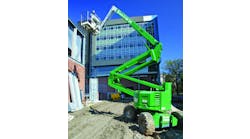Everybody felt it, in every business in every state, city and hamlet in North America. It was the fiercest recession they'd ever seen and virtually everyone on the RER 100 agreed. Economists called it the perfect storm of factors producing a catastrophic recession.
We also saw resiliency everywhere, the refusal to quit. Determination because their businesses were based on something solid and concrete, a sense of service, the fiber of the communities they lived in, builders and those who provided the materials to be builders.
Rental companies throughout North America downsized their fleets, let go of staff, closed branches, and cut costs every way they could. It was often painful and it often meant letting go of solid, loyal people with families and mortgages and kids in school during a period of skyrocketing unemployment. It meant painful conversations and difficult decisions, and no companies were exempt.
One of the hardest parts for many was the uncertainty, the feeling that it could last for years. Most rental company owners believe there is a hint of hope in the second half of 2010, or perhaps in 2011. There are a lot of economic indicators pointing in that direction: Customers bidding on more jobs, a bit more stimulus money being spent, roads and bridges being rebuilt. Inventories of empty houses are going down in many areas, some companies are hiring again. But credit remains tight, joblessness rampant and while some customers say there will be some projects coming up, other customers just simply were no longer there.
The RER 100 in 2010 covering 2009 volume decreased 25.3 percent compared with 2008 volume numbers, the largest single-year drop in the history of the chart, dating back to 1986. The top 10 of the RER 100 dropped 26.3 percent. The average rental volume decrease from companies with reported volumes in 2009 and 2010 — we can say it's the RER 100 equivalent of same-store growth or income from continuing operations — was 23.7 percent. Many were in the 30-percent range, even 40 or 50 percent plus. Fewer were single digit. Less than a handful realized increases. And for most, the first quarter of 2010 started out worse than 2009.
The national rental players set the tone in 2009 and going into 2010 by concentrating on improving their balance sheets, improving free cash flow generation and greater operating efficiencies designed to improve performance for the long term as well as solving short-term concerns. “We will enter the recovery with ample capital to invest in growth and with our arms more vigorously around value creation,” said industry leader United Rentals (No. 1) in its annual report. United Rentals, for example, reduced staff by 19 percent, not an uncommon number among the RER 100, and certainly not the highest.
The dramatic downturn in commercial construction was the common denominator faced by the RER 100 in 2009. The National Bureau of Economic Research determined that the recession in the United States began in December 2007 with private non-residential construction weakening throughout 2008 and 2009, exacerbated by the credit crisis that began in late 2008. Most forecasts are for commercial construction to continue to decline in 2010, although many companies are expecting improvement in the second half of 2010.
According to Gerry Plescia, president of Hertz Equipment Rental Corp. (No. 4), the first quarter of 2010 may have been the bottom point of the recession as it affects the rental industry.
“The decline into the winter season in the U.S. was much less severe than during the 2008-09 winter,” says Plescia. “What was really encouraging was we're seeing business, from the very first of the year and end of the holidays through today, grow from December 31 levels, which is a different pattern from last year where we saw business declining month after month from December to January to February to March and so on. This year the trajectory has been more normal where we see a seasonal improvement month after month in rental volume. On the commercial side, though it's still negative year over year, we're seeing a sequential improvement in projects coming out of the ground, February better than January, March better than February.
“It appears the first quarter of 2010 will be the cyclical and season trough of the recession. I think we'll see progressive seasonal growth and from a volume perspective, sometime early in the third quarter we may see a positive year-over-year volume move in the business.”
Charles Snyder, executive vice president fleet operations for Sunbelt Rentals (No. 3), agrees. ““We're not predicting any kind of a v-shaped upturn, but we are looking at sequential improvement throughout the calendar year with more acceleration of that improvement in the back half,” he says.
Almost everybody on the RER 100 agrees that this was the most difficult year they'd ever experienced in their history in the rental industry, whether they'd been in the industry 10 years or 40.
“Other than our very first year in business 40 years ago, 2009 was, by far, the most difficult,” says Bill Thompson, CEO of Thompson Pump (No. 56). “The projects were scarce; the competition was fierce; revenue declined but costs remained consistent, or even increased in some areas. [It was almost impossible] to obtain financing; governmental regulations and mandates seemed to hit us from all directions; it was impossible to forecast materials requirements with any degree of accuracy; personnel considerations were high priority; this list is never-ending.”
“The fundamental drivers of our business (housing construction, non-residential construction) are broken,” adds Jamie Cowin of Cowin Equipment Co. (No. 62). “There is no private work out there. Banks are still under duress and are very loathe to lend to real estate or construction projects especially. That is in the early stages of healing, but until credit returns it would be unrealistic to expect significant improvement in the rental industry. However, there are two positives. First, stimulus projects should be at least two-and-a-half times as plentiful as in 2009. Second, and more importantly, the desire on the part of contractors to rent in lieu of purchase will remain strong. Many would-be buyers are reluctant to commit to a purchase or cannot be financed even if they want to buy. As such, the pendulum of equipment use/ownership will swing more and more towards rental.”
Cowin, who says business is beginning to pick up, points out there have been some silver linings. “The recession gives us a chance to right-size our fleet, gives us a chance to take a look at everything the busyness of the past few years covered up.”
While some companies have looked at different product lines and explored market opportunities, the popular business concept that a downturn is a good time to expand to gain market share was not typically followed in the past year. A few companies, most notably Ahern Rentals (No. 7), expanded their footprint and opened branches in order to utilize equipment coming off of jobs that were not likely to be rented. For Ahern and others, the fact that the used equipment market was flooded with equipment and prices were soft, opening branches seemed the only way to get some return from their fleet. But for most, lack of capital made expansive moves not a favorable option.
“It has been our experience that when the economy dips this dramatically, you can't sell your way out of it with new markets and new lines,” says Walter Berry, Berry Companies (No. 87). “You have to streamline your operations to the size of the new market. We did expand into the Dallas/Ft. Worth markets with Bobcat. But, that market looks like most of our other markets (economy wise) and did not significantly affect our financial results positively or negatively.”
For the most part, RER 100 executives have focused on moving forward despite the difficulties. Woody Weld of Acme Lift (No. 64) perhaps expresses it best:
“Be flexible, look for new opportunities, keep acquiring new customers and take great care of all of your new and older customers alike, move quickly to take advantage of opportunity, keep your great employees and don't cut them back financially if possible (they don't experience the highs that owners do so try to keep them from experiencing the lows as well). Build cash as much as possible, begin to think about your next borrowing source because opportunity may present itself sooner than you think, focus on training and internal systems while business is slow and allows for introspection. Help your friends in business during hard times because all of us need help and difficulties teach each of us new and important things. Try not to expend too much energy fighting with customers and employees because it is energy wasted. Try to remember what is really important in life and focus upon it relentlessly.”
With those thoughts in mind, most RER 100 executives expect a more positive report next year. But uncertainties and tough times remain.





